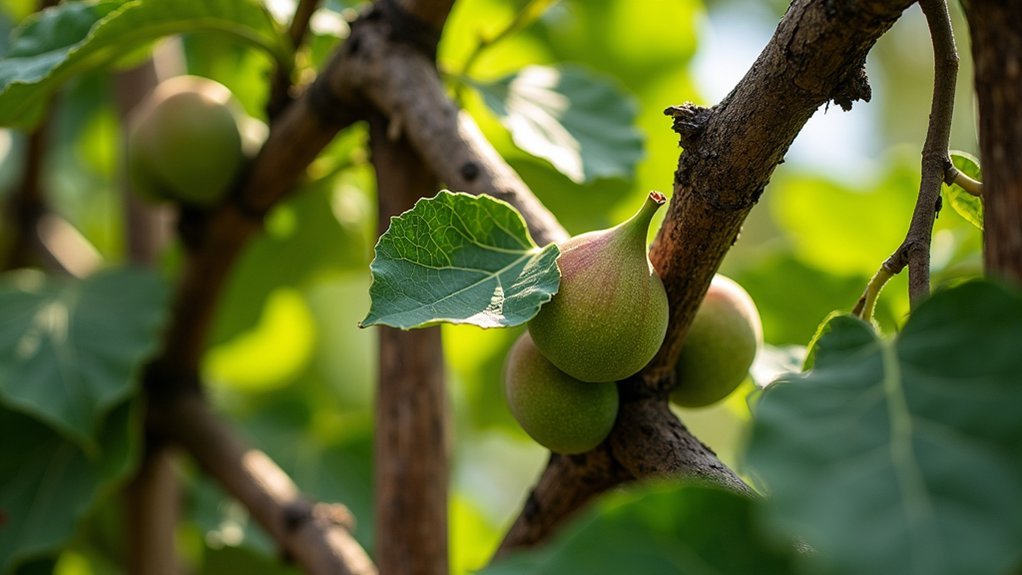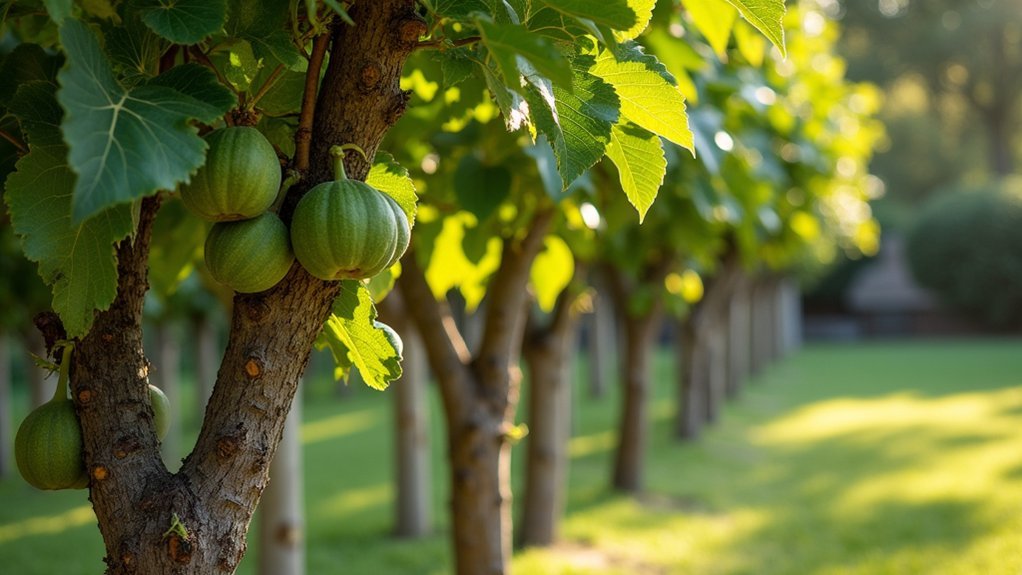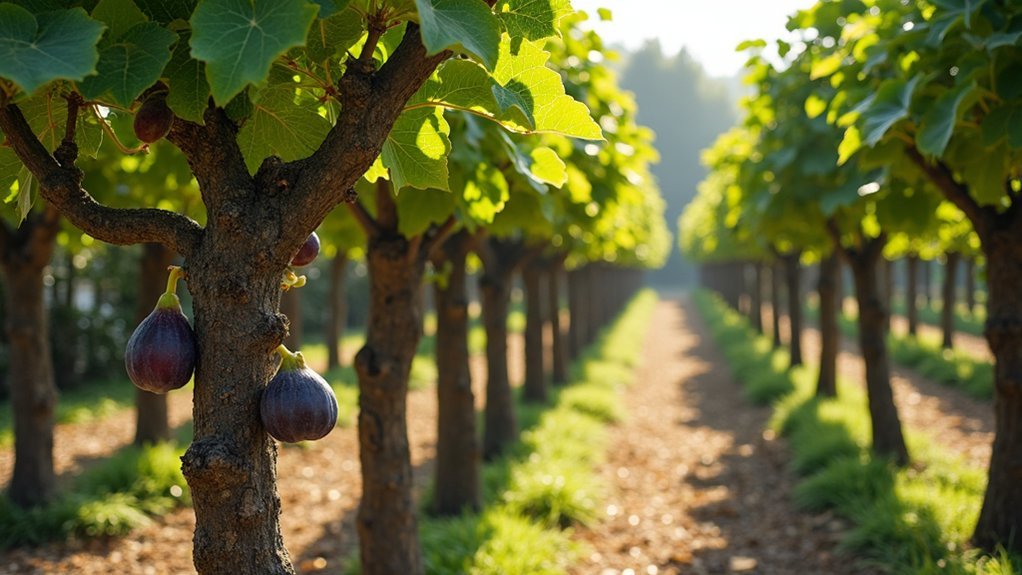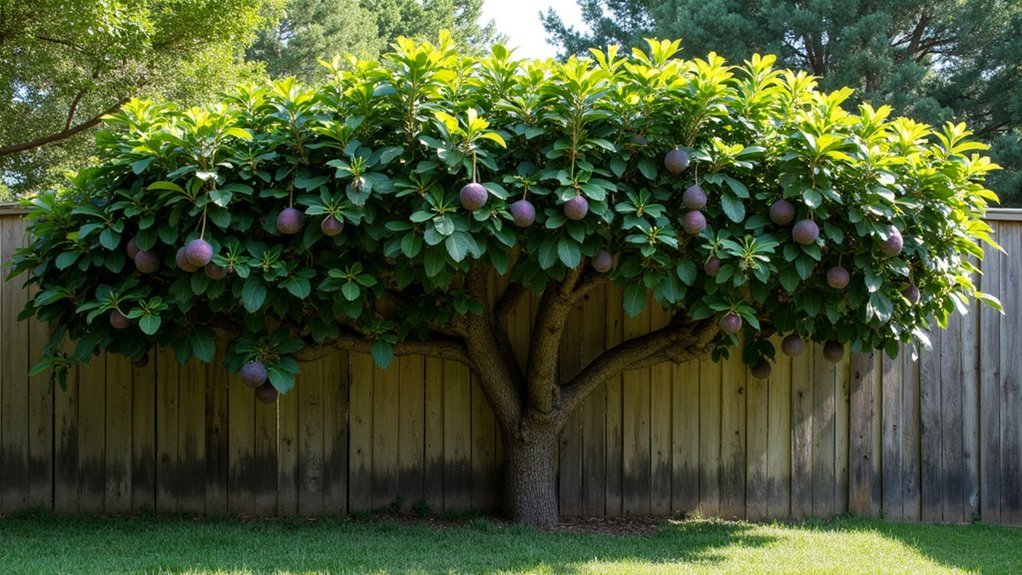Fig trees make ideal espalier choices for boundaries because their flexible branches easily train into decorative patterns while transforming vertical spaces into productive growing areas. You’ll enjoy increased fruit yields, better air circulation, and improved sun exposure compared to free-standing trees. Their adaptability to various training techniques, including low-cordon systems, maximizes limited space without sacrificing productivity. Position them 8-10 feet apart with proper support systems for best results. Discover how these versatile trees can turn ordinary boundaries into beautiful, bountiful assets.
The Space-Saving Advantage of Fig Espaliers

Garden real estate is precious, and fig espaliers offer an ingenious solution for space-conscious gardeners. By training these trees against walls or trellises, you’ll transform vertical boundaries into productive growing areas without sacrificing valuable ground space.
Fig trees are particularly well-suited for this technique thanks to their flexible branches, which can be easily manipulated into decorative patterns like fans or candelabrums. This adaptability makes them perfect candidates for small gardens or urban settings where space comes at a premium.
Beyond aesthetics, espaliered fig trees deliver an increased fruit yield compared to their free-standing counterparts. The training process improves air circulation around developing fruits while maximizing sun exposure.
You’ll enjoy abundant harvests from a fraction of the space traditional orchards require, proving that limited square footage needn’t limit your gardening ambitions.
Selecting the Right Fig Varieties for Boundary Training
While any fig tree can theoretically be espaliered, choosing the right varieties greatly impacts your success with boundary training. When establishing fig trees along boundaries, prioritize varieties that produce consistent main crops and tolerate harsh pruning.
| Variety | Benefits | Climate Suitability | Training Ease |
|---|---|---|---|
| Ronde de Bordeaux | Heavy main crop | Cool to moderate | Excellent |
| Natalina | Hardy, productive | Mediterranean | Very good |
| Florea | Early ripening | Various | Good |
| St. Rita | Reliable fruiting | Diverse conditions | Excellent |
Early-ripening varieties guarantee you’ll harvest fruit before winter arrives, making your espalier boundary both productive and attractive. Fig trees’ naturally flexible branches make them ideal candidates for boundary training. Don’t forget to take into account your local climate when selecting varieties—this greatly influences which fig will thrive in your espalier boundary system.
Creating the Framework: Support Systems for Fig Espaliers

After selecting the perfect fig varieties for your boundary project, you’ll need to establish a robust support framework to guide their growth.
Unlike espaliered apples, fig trees have more flexible vertical branches requiring sturdier support structures. Your trellis should maintain 15-25 cm of clearance between the wall and your fruit trees to guarantee proper airflow and sunlight penetration.
Fig espaliers need robust trellising set 15-25 cm from walls to support flexible branches while ensuring vital airflow and sunlight access.
Choose durable materials like treated wood or metal wire that will withstand years of supporting your growing figs.
Design your framework with multiple tiers to maximize space and fruit production. This vertical training method allows figs to thrive even in compact gardens.
Remember to regularly inspect your support structure for stability, replacing any worn components promptly. With proper installation and maintenance, your fig espalier system will provide both beautiful boundaries and abundant harvests for years to come.
Seasonal Maintenance and Pruning Techniques
Mastering the seasonal rhythm of pruning transforms your espaliered fig trees from mere boundary plants into productive living sculptures.
In spring, trim excess shoots to maintain 15-20 cm spacing between branches and tie vertical growth to supports.
Summer calls for regular maintenance—remove vertical shoots to two buds to maintain the desired shape and encourage fruit production on horizontal branches.
Come fall, cut back vertical branches to within an inch of the cordon, leaving 2 cm nubs to stimulate new growth. Align cordon ends with your permanent framework.
During your first year, focus on establishing a single tall whip, then develop scaffolds in subsequent seasons.
Don’t neglect winter pruning—it’s essential for tree health, preparing your living boundary for the next growing season’s productivity and maintaining its architectural elegance.
Maximizing Fruit Production Along Boundary Lines

You’ll need to position fig trees 8-10 feet apart along your boundary to achieve ideal productivity while allowing sufficient airflow between specimens.
When training young branches, secure them horizontally at 45-degree angles to encourage fruit-bearing spurs rather than vegetative growth.
This strategic arrangement creates a living fence that maximizes your spatial efficiency, turning boundaries into productive growing zones rather than wasted garden real estate.
Optimal Spacing Techniques
While establishing your fig espalier, precise spacing becomes the foundation for abundant harvests along boundary lines. Position your trees 15-25 cm from walls or trellises to guarantee ideal air circulation and sunlight exposure—critical factors for maximizing fruit production when espaliering fig trees.
- Maintain 15-20 cm between branches to balance growth and yield
- Implement the low cordon espalier technique for thriving figs in limited spaces
- Select early-ripening varieties like ‘Ronde de Bordeaux’ for extended harvests
- Train the main stem horizontally to increase crop size in compact areas
- Space multiple trees strategically to enhance overall garden productivity
With proper spacing, your espalier fig trees will reward you with consistent fruit from June through November, transforming ordinary boundaries into productive growing zones.
Training Young Branches
Flexible fig branches bend readily to your will, making them ideal candidates for espalier training along boundaries. You’ll appreciate how quickly these adaptable trees reward your efforts, often producing fruit by their second year when properly trained.
When training young branches, maintain 15-20 cm spacing between them to optimize light exposure and air circulation—critical factors for healthy fruit development. Implement the low-cordon technique to simplify winter protection while ensuring your trees remain productive with minimal effort.
Regular summer spur pruning encourages new shoots and stimulates fruiting wood development. This disciplined approach to espalier training transforms boundary lines into productive growing spaces.
Combining Aesthetics and Function in Fig Tree Boundaries
You’ll create striking vertical interest with espaliered fig trees while maximizing your limited garden space.
Their flexible branches can be trained against walls or fences, transforming ordinary boundaries into productive, ornamental features.
This dual-purpose approach gives you both an attractive living screen and a convenient source of fresh figs throughout the growing season.
Striking Vertical Impact
Transforming garden walls and boundaries, espaliered fig trees create dramatic vertical interest that few other plants can match.
When you train fig trees along a vertical boundary, you’ll achieve both architectural sophistication and space efficiency. The flexible branches conform beautifully to your desired patterns, creating living artwork that enhances your garden’s depth and dimension.
- Creates visually striking silhouettes against plain walls
- Provides year-round structure with seasonal interest
- Frames garden views while maintaining sightlines
- Establishes clear spatial definition without solid barriers
- Offers visual height that draws the eye upward, expanding perceived space
Your espaliered fig trees won’t just serve as beautiful garden features—they’ll function as practical living screens that improve air circulation while providing shelter from wind and prying eyes.
Space-Efficient Fruit Production
While many gardeners focus solely on ornamental value, espaliered fig trees offer the perfect marriage of beauty and bounty in limited spaces. Their flexible branches adapt perfectly to training against walls, creating a space-efficient design that transforms ordinary boundaries into productive assets.
You’ll find the low-cordon technique particularly valuable for potted fig cultivation. By guiding horizontal branches along a support system, you’re maximizing fruit production while minimizing the footprint.
Place your espalier in a protected spot where it benefits from improved air circulation and sunlight exposure—critical factors that reduce disease risk and enhance fruit quality.
What’s particularly advantageous is how figs produce on new wood, ensuring consistent harvests without complex maintenance. This approach makes fruit more accessible at picking time, allowing you to enjoy both the visual structure and delicious rewards of your living boundary.
Frequently Asked Questions
Can You Espalier a Fig Tree?
Yes, you can espalier a fig tree. They’re excellent candidates due to their flexible branches. You’ll need to regularly prune them to maintain shape, but they’ll thrive in limited spaces while maximizing fruit production.
What Is the Best Fruit Tree for Espalier?
Figs are the best espalier choice, but you’ll also find apples, pears, and stone fruits excellent. You’ll appreciate their flexible branches, quick fruiting, and ability to produce even after heavy pruning.
What Is the Significance of the Fig Tree?
The fig tree’s significance spans cultural symbolism of abundance, nutritional value with rich vitamins and fiber, historical importance in Mediterranean civilizations, and versatile cultivation abilities. You’ll find it’s revered in many religious traditions too.
How Close to a Fence Can You Plant a Fig Tree?
You should plant fig trees at least 15-25 cm (6-10 inches) from a fence. For larger varieties, maintain 30 cm (12 inches) to prevent moisture buildup, guarantee proper airflow, and allow access for pruning.
In Summary
You’ll find that espaliered fig trees offer the perfect blend of utility and beauty along your property lines. They’ll save precious space while providing abundant harvests right where you need them. With proper variety selection, sturdy support systems, and regular maintenance, your fig espaliers will create living boundaries that delight the senses and serve your garden for years to come.





Leave a Reply